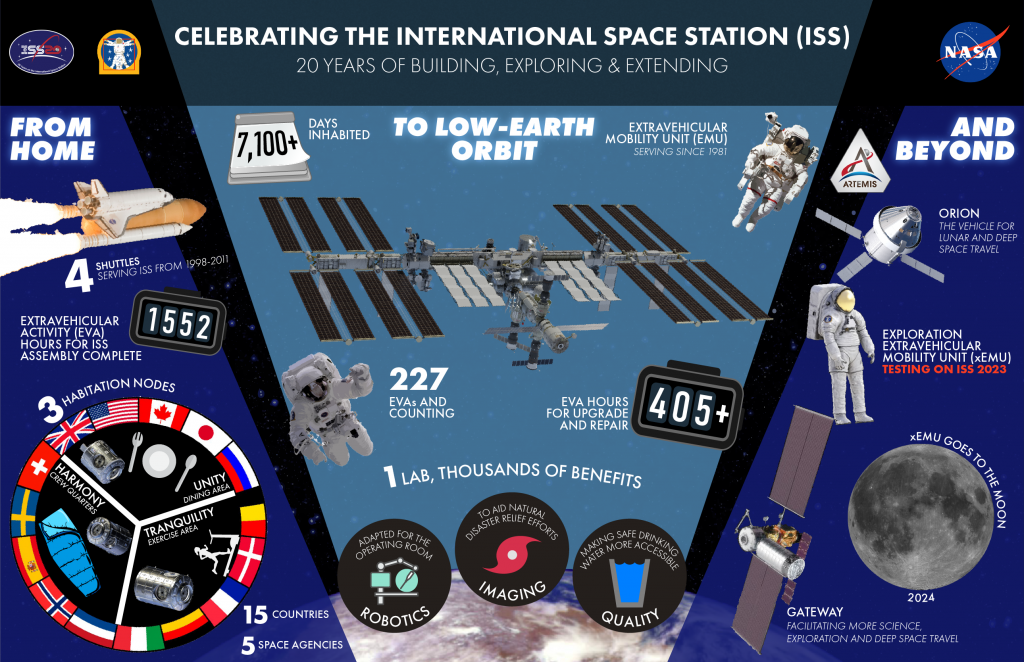Context:
- As tensions simmer between Russia and a number of Western countries on the ground, the head of the Russian space agency has announced work has begun on a space station of its own.
- Russia recently celebrated its proud history in space, marking the 60th anniversary of Yuri Gagarin becoming the first human to go into orbit.
- For years, Russia had a monopoly on manned space flight but in 2020 NASA astronauts were taken to the ISS via a capsule belong to Elon Musk’s SpaceX.
Relevance:
GS-III Science and Technology: (Space Technology, Developments in Space technology)
Dimensions of the Article:
- What is a Space Station?
- How are space stations set up and how do they work?
- International Space Station (ISS)
- Russian withdrawal from the ISS and its new Space Station
- ISRO’s space station ambitions
What is a Space Station?
- A Space station is an artificial structure placed in orbit, having the pressurized enclosure, power, supplies, and environmental systems necessary to support human habitation for extended periods.
- In simple words: a space station, also called an orbital station, is a large spacecraft or man-made station in space which can act as a home where astronauts live and/or receive several spacecrafts from the Earth and/or act as a kind of science lab, etc.
Depending on its configuration, a space station can serve as a base for a variety of activities. These include observations of the Sun and other astronomical objects, study of Earth’s resources and environment, military reconnaissance, and long-term investigations of the behaviour of materials and biological systems—including human physiology and biochemistry—in a state of weightlessness, or microgravity.
How are space stations set up and how do they work?
Small space stations are launched fully assembled, but larger stations are sent up in modules and assembled in orbit. To make the most efficient use of its carrier vehicle’s capacity, a space station is launched vacant, and its crew members—and sometimes additional equipment—follow in separate vehicles. A space station’s operation, therefore, requires a transportation system to ferry crews and hardware and to replenish the propellant, air, water, food, and such other items as are consumed during routine operations. Space stations use large panels of solar cells and banks of storage batteries as their source of electrical power. They also employ geostationary relay satellites for continuous communication with mission controllers on the ground and satellite-based positioning systems for navigation.
How many Space Stations have we launched?
Since 1971, more than 10 space stations have been launched into a low orbit around Earth and have been occupied for varying lengths of time.
Important Space stations in chronological order are Salyut 1, Skylab, Salyuts 3, 4, 5, 6, and 7, Mir, the International Space Station, and Tiangong 1 and 2.
International Space Station (ISS)
- The International Space Station (ISS) is a modular space station (habitable artificial satellite) in low Earth orbit.
- The ISS program is a multi-national collaborative project between five participating space agencies: NASA (United States), Roscosmos (Russia), JAXA (Japan), ESA (Europe), and CSA (Canada).
- The ownership and use of the space station is established by intergovernmental treaties and agreements.
- The ISS serves as a microgravity and space environment research laboratory in which scientific experiments are conducted in astrobiology, astronomy, meteorology, physics, and other fields.
- It is the largest artificial object in space and the largest satellite in low Earth orbit, regularly visible to the naked eye from Earth’s surface.
- The ISS is the ninth space station to be inhabited by crews, following the Soviet and later Russian Salyut, Almaz, and Mir stations as well as Skylab from the US.

Russian withdrawal from the ISS and its new Space Station
- Russian officials have indicated they could pull out of the ISS in 2025 as the station’s structure is ageing and also the Russian space agency, Roscosmos, says that its agreement with the international partners runs out in 2024.
- Appearing to pre-empt the decision to exit – the head of Roscosmos posted a video showing that the first core module of the new Russian orbital station is in the works and it is aimed at being made ready for launch in 2025.
- The Russian space module, being assembled by the Energia corporation, is set to cost at least $5bn.
- The planned Russian space station would orbit at a higher latitude and thus be better able to view the polar regions, which would be useful for the opening up of the Northern Sea Route. Russia hopes to develop the route as Arctic sea ice melts.
ISRO’s space station ambitions
- Indian Space and Research Organization (ISRO) has announced its ambitious plan to put up a space station in the next decade.
- The Indian space station will be much smaller (mass of 20 tonnes) than the International Space Station and will be used for carrying out microgravity experiments (not for space tourism).
- Preliminary plan for the space station is to accommodate astronauts for up to 20 days in space, and the project will be an extension of the Gaganyaan mission.
- It will orbit Earth at an altitude of around 400km.
- ISRO (Indian Space Research Organisation) is working on space docking experiment (Spadex), a technology that is crucial for making the space station functional. (Space docking is a technology that allows transferring humans from one spacecraft to another.)
- The International space station (ISS) is currently the only active space station (Operating and permanently inhabited) in the Earth’s orbit.
-Source: The Hindu



